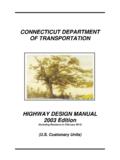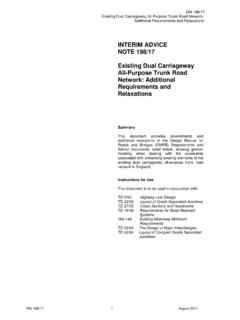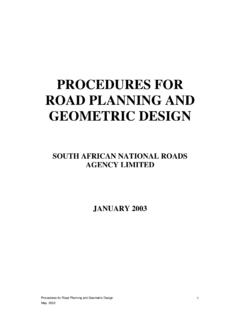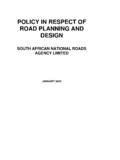Transcription of VALUE ENGINEERING PROGRAM - Connecticut
1 VALUE ENGINEERING PROGRAM ~ November 2009 ~ Connecticut DEPARTMENT OF TRANSPORTATION BUREAU OF ENGINEERING AND CONSTRUCTION Office of Quality Assurance VALUE ENGINEERING PROGRAM November 2009 2 TABLE OF CONTENTS Introduction 3 VALUE ENGINEERING PROGRAM Overview 4 Project Selection 4 VE Study Levels 5 Timing 5 Study Team 6 Study Procedures VE Job Plan 7 VE During Construction 8 PROGRAM Monitoring and Reporting 9 Appendix A: VE Study Requirements Checklist 10 Appendix B: Sample Letter to FHWA 11 Appendix C.
2 FHWA Annual Report Form 12 VALUE ENGINEERING PROGRAM November2009 3 Introduction VALUE ENGINEERING (VE) is a systematic process using a team from a variety of disciplines to improve the VALUE of a project through the analysis of its functions. The VE process incorporates, to the extent possible, the values of design , construction, maintenance, contractors, state, local and federal approval agencies, other stakeholders, and the public. In accordance with 23 CFR Part 627, State highway agencies must establish programs to assure that VE studies are performed on all Federal-aid highway projects on the NHS (National Highway System) with an estimated cost of $25 million or more and for bridge projects with an estimated cost of $20 million or more.
3 The Office of Quality Assurance, in cooperation with the design team, should identify and implement VE studies on additional projects with characteristics or factors that may offer improved VALUE . Factors may include more than one alternative, complexity, fast track scheduling, controversial components, innovation, traffic impacts or scope creep. Projects meeting the underlined criteria above must have a documented VE study performed in a timely manner. Failure to conduct a VE study as stipulated by federal requirements may result in delays in authorization of construction funds for those federal-aid projects meeting the criteria that have not had a VALUE ENGINEERING study performed. Previously, VE studies were conducted through the Department s Consultant design Division as an adjunct to the selected project s scope of services.
4 The oversight of the VALUE ENGINEERING PROGRAM is now administered by the Office of Quality Assurance (OQA). This document will serve as a guideline to maintain the VALUE ENGINEERING PROGRAM within the Connecticut Department of Transportation. As such, the document itself will be subject to revision and maintenance as needed. Any modifications/updates to this document should be coordinated with the Federal Highway Administration (FHWA). VALUE ENGINEERING PROGRAM November 2009 4 VALUE ENGINEERING PROGRAM Overview The Connecticut Department of Transportation will administer a VALUE ENGINEERING PROGRAM wherein certain projects in design will be systematically reviewed for potential cost savings.
5 A VALUE ENGINEERING team will typically meet for a one week period and present their recommendations to the Department s designer(s) for evaluation and, if acceptable, implementation. The VE study will have the following objectives: Increase VALUE Maintain function and scope Minimize life cycle costs Encourage innovation Highlight potential cost reduction on transportation improvement projects Produce a higher quality, more efficient transportation project Project Selection The trigger for VALUE ENGINEERING studies to be warranted is first evident at Project Scoping when the Department s design team estimates that the preliminary total project costs, including Environmental studies, Preliminary ENGINEERING , Final design , ROW and Construction costs of the project, will exceed the identified cost criteria (see below). At any time during the project development that the Engineer s Estimate indicates the total project costs will exceed the identified cost criteria, the design Project Manager is to notify OQA that a VE study must be implemented.
6 The current cost criteria for a VE study are as follows: Federal-aid highway projects on the NHS $25 Million or more estimated project cost Federal-aid bridge projects $20 Million or more estimated project cost Other projects may also be selected for VE studies. In addition to the cost, other issues adding to the complexity of the project design should be considered in the selection process. These complexities may include: critical constraints, difficult technical issues, expensive solutions, external influences, or complicated functional requirements. The types of projects that usually provide the highest potential for VALUE improvements are: Projects with alternate solutions which vary the scope and cost New alignment or by-pass sections Widening existing highways for capacity improvements Major structures Interchanges on multi-lane facilities Projects with extensive or expensive environmental or geotechnical requirements Difficult materials requirements or inferior material sources Major reconstruction of existing highways Projects with major traffic control Projects with multiple stages VALUE ENGINEERING PROGRAM November2009 5 OQA personnel will track all potential projects due for VE studies.
7 The initial indicator tool is the Department s Working Schedule of Federal-Aid Obligations compiled by the Office of Capital Services. OQA compiles and updates a list of projects due for VALUE ENGINEERING studies, adding or removing projects as project estimates go through refinements. OQA shall ensure that a listing of all federally funded projects planned for VE studies is forwarded to FHWA on a semi-annual basis. The Department s designers will play a major role in identifying candidate projects for VE studies. Whenever a VE study is required, the project s budget and schedule should be adjusted to reflect the additional resources necessary to complete the study. VE Study Levels The Department has established two (2) levels of VALUE ENGINEERING studies: Level A, and Level B. The level chosen will dictate the composition of the study team and the scope of the procedures to be followed.
8 The Level A study is the most comprehensive and should be considered for complex projects, new construction, capacity improvements, and major reconstruction. This level will typically involve task-based consultant engineers with particular expertise relating to the type of project under study. The Level B study should be considered for maintenance type work (paving, guiderail, drainage improvements) and replaced-in-kind work where no additional capacity is gained. Level B studies may be completed by task-based consultant or in-house staff. Once a project is selected for study, OQA and the design team will determine the level of study and composition of study team. Later sections of this document contain more specific information about the personnel and procedures to be utilized in Level A versus Level B studies. Timing The timing of when to conduct the VE study is important.
9 The Department has completed studies at various times in the project schedule. Many projects have gone all the way to final design before a VE study is done. When a study is done at that late of a stage, it is costly and difficult to implement any recommendations from the VE study. It is recommended that the VE study be completed as early in the design process as possible. VE is more effective and influential on performance, quality, and cost of a project when done relatively early in the project schedule. When 30% plans of projects due for VE studies are available, OQA will begin to assemble a study team. OQA will be responsible for scheduling the location(s) and necessary personnel, both Department and Consultant, to conduct the VE study. VALUE ENGINEERING PROGRAM November 2009 6 Study Team The VALUE ENGINEERING study team, either Level A or Level B, must be totally independent of the design team and will typically consist of a Team Leader and five to seven other members with expertise in various specialties related to the project.
10 OQA will coordinate with the project designer to determine the ENGINEERING disciplines that should be represented on the VE study team. When necessary or appropriate the OQA may also utilize a consultant ENGINEERING firm specifically contracted by the Department for VE services to assemble the team. For each VE effort initiated, OQA shall ensure FHWA is offered the opportunity to attend and participate. (FHWA Major Projects Team Leader 860-659-6703 ext. 3008) To ensure a productive and focused VE effort, the Team Leader should be a Certified VALUE Specialist (CVS), certified by SAVE International, or a Professional Engineer registered in the State of Connecticut , with a minimum of ten years of experience related to roadway or bridge design , roadway or bridge construction, maintenance or a specific ENGINEERING discipline required by the project. For a Level A study the Team Leader should be a CVS who has experience with VE studies.















